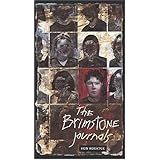Kuertge, Ron. 2001. The Brimstone Journals. New York: Candlewick Press. ISBN: 0763613029
Branston High School, nicknamed Brimstone by its occupants, is a typical suburban high school in America. You have the jock, the nerd, the fat kid, the lesbian, and every other “label” high school students give each other. In The Brimstone Journals, Koertge gives readers a glimpse into the personal thoughts of each of these fifteen students by recording their thoughts and feelings in journal form.
What joins the students together, whether they know it or not, is Boyd, an angry young man with a list of “everybody who ever blew me off, flipped me off, or pissed me off” (Koertge 51). When he meets Mike, Boyd begins to plan a Columbine type event where he gets revenge against all those he thinks offended him. Other students are sucked into his plan either by joining in the attack or having their name added to the list. One student bravely thwarts Boyd’s plan, and the aftermath of the “event” showcases teenagers at their best: living in the moment. Although a few students have their lives changed like Sheila opening up to her mother about her struggle and Allison telling the counselor what her stepfather is doing to her, most students immediately go back to the frivolous cares of high school. Damon, the controlling boyfriend jock, immediately goes back to wondering when his girlfriend will come back to him. Rob still doesn’t understand why he was on the list. Even Lester, the hero of the book, contemplates his actions for a minute and then immediately thinks about going to prom with Meredith. Boyd exemplifies this even further as with one sentence he is choosing to help kill his peers and in the next, he’s thinking about a tattoo.
Boyd
I was gonna drop out of school until
Mike got me to see how we need
People who can lead the foot soldiers.
Somebody the grunts can look up to.
So I’ll march up there and shake some total
phony’s hand.
Plus, Mike’s springing for a tattoo when I
get my diploma.
(Koertge 31)
Although Koertge gives a voice to the average high school students in this book, the book felt incomplete in some way. Because there were fifteen voices to hear in only 113 pages, some voices were not developed completely nor did their few entries do their stories justice. However, the many voices join together cohesively to tell the unified story of a high school on the edge of an attack by one of its students. Each unique voice tells a different side or perspective of the story that the reader would not have seen if the story had been written in standard prose. The pattern of the poems (some one sentence in length while others two pages) resonates the disjointed feelings of teenagers.
Each day, millions of teens around the country go to school with different problems and situations in which they feel isolated and alone. In this book, Koertge gives them a voice. Before reading the book, a history, psychology, or English teacher could have an introduction lesson using articles out of today's newspapers and magazines about students committing violent acts at school. The events in recent history make the book relevant to today's teen. Because the poems are short and the book a fast read, the teacher should read the whole book with the class in order to see the full ramifications of the character's action. In addition to great discussions about life, fitting in, and isolation, the poems lend themselves to discussions about character traits, development, and change throughout a story. Comparing the change in Allison to the lack of concern by Rob clearly shows character development and the lack of it. Finally, students can then write about their own struggles and perhaps even get some help if they need it.


No comments:
Post a Comment